The thousand faces of Heinrich Schliemann, the man who ‘discovered’ Troy
With a vast exhibition, Berlin celebrates its most famous archaeologist, an uneducated millionaire who used his fortune to search for Homer’s heroes
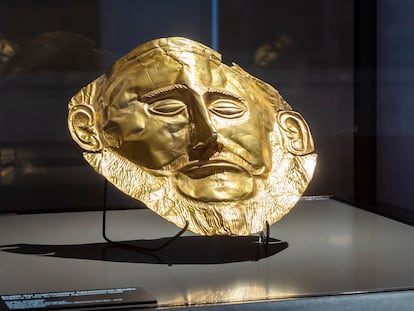

Heinrich Schliemann had a dream. He was convinced that the Troy that Homer talked about actually existed, and that he could find it by studying the Iliad and the Odyssey in depth. Little did he care that his contemporaries mocked him for using epic poems of dubious credibility as a guide to undertake an archaeological campaign. He had money and determination. The wealthy Prussian businessman ruled out what was previously suspected to be the location of the mythical city (Bunarbashi, in present-day Turkey), as it was too far from the sea and the Greek soldiers would not have had time to cover the distance six times in one day, as recounted in the Iliad.
However, the hill of Hisarlik – also in Turkey – had the right topography. That is where Schliemann ordered his team to start digging a ditch until they reached the last of a series of superimposed layers of ancient remains. Then a lavish treasure of gold and silver that could only belong to King Priam appeared. Or so Schliemann believed, and in 1873 he astonished the world with his fabulous find. A famous photo that he took of his wife Sophia wearing a gold diadem, like a Helen of Troy, contributed to bringing him instant fame.
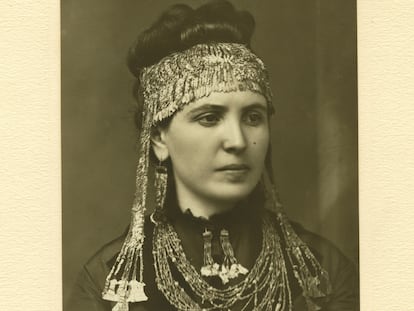
To commemorate the bicentenary of his birth, Berlin is holding an extensive exhibition dedicated to the multifaceted personality of this pioneer of modern archeology and his controversial working methods. The Worlds of Schliemann, divided between the James-Simon-Gallery and the Neues Museum, presents, through 700 objects (many of them on international loans), the amazing story of an adventurer who had, as curator Matthias Wemhoff puts it, “a life in which several lives fit.” A merchant in Russia, a banker in California, the writer of travel guides on the Far East; Schliemann was all that until, after 40, he decided to reinvent himself and pour his fortune into his true passion: Greek antiquity.
The exhibition begins with a story fit for a movie: the shipwreck in which a 19-year-old Schliemann, on his way to Venezuela to earn a living, almost drowned. The son of a pastor who abused alcohol and mistreated his mother, Schliemann was born in 1822 in Neubukow, Mecklenburg (Germany), where he could not finish secondary education because the family lacked the means. The shipwreck story is the first in which a tendency to embellish and dramatize can be observed; a tendency that would later lead him to make up – or at least exaggerate – some of his achievements. Three narrations of what happened off the coast of the island of Texel, in the Netherlands, have been preserved; all are different. He sent his sister the most dramatic story in a letter. “He understood his life as an adventure, and he described it as an adventure,” Wemhoff says.

After the accident his plans changed. He moved to Amsterdam, where he began to manage a company dedicated to trade. Thanks to his incredible ability with languages, he was posted to St. Petersburg, and soon after he established himself. The trade in indigo and other products, including weapons, during the Crimean War (1853-1856) made him a wealthy man. From that time is the famous photograph of a thirty-something Schliemann with a top hat and an ostentatious fur coat (taken in the summer) with which he intended to leave proof of his good position. Obsessed with recognition, he would receive an award from the trade union and obtain Russian nationality.
Thanks to his many businesses — he also founded a bank in California during the gold rush — he was able to amass a fortune big enough to retire at 36. After that he devoted his time to traveling the world: he explored parts of America and Asia and published his first book, on China and Japan. Determined to complete the education he could not afford as a young man, he settled in Paris and enrolled at the Sorbonne. Meanwhile, he divorced his Russian wife. He learned Latin and Greek. His first research campaign took him to Greece in 1868, where he searched for Odysseus’ palace in Ithaca. But his goal was Troy.
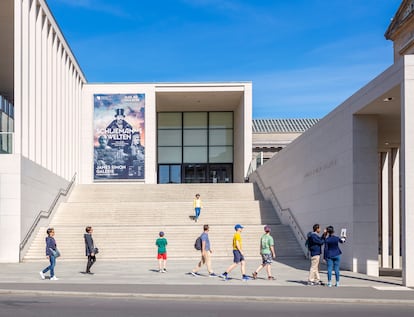
Wemhoff explains that Schliemann fantasized about the origin of that obsession in his memoirs: one Christmas, when he was a child, his father allegedly gave him a book on universal history, which included an engraving of Aeneas in front of the walls of Troy. It fascinated him: “Father, I am sure that Troy exists and that I will be the man that will find it.” As made-up as that line is, Wemhoff does not rule out that he did read that book – a German copy of the time is shown – and that Troy made a great impression on him.
The second part of the exhibition focuses on his archaeological discoveries. Despite his reputation as a charlatan and a bluffer, Schliemann was also a self-made man academically. He wrote a thesis and obtained a doctorate from the University of Rostock (Germany). But he did it at 47, and was never taken seriously by most academics at the time.
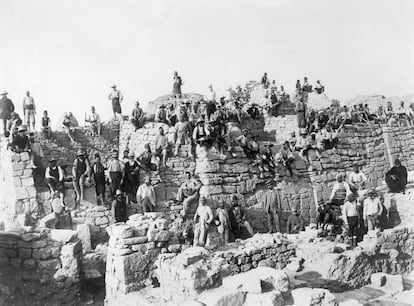
An avid discoverer
Even though Troy and Priam’s treasure brought him worldwide fame, his discovery of the Mycenaean culture, the first advanced civilization in Europe (a thousand years older than what was known at the time), is much more important. In Mycenae, where he began excavating in 1876 in search of more Homeric heroes, he found the remains of a citadel, the famous Lion Gate and several royal tombs, among which he thought was that of Agamemnon. The most spectacular find is a gold funerary mask that he attributed to the Mycenaean king but that, according to later studies, is from about 300 years earlier. Schliemann dubbed it the “Mask of Agamemnon,” and that is how it is still known. The exhibition includes a copy of the original, which is in the Archaeological Museum of Athens.
The eccentric millionaire, who mastered 12 languages and patented his own language learning system, devoted the rest of his life to archaeology. After Mycenae, he excavated in Tiryns, where he discovered the impressive wall paintings of the Mycenaean palace, and in Orchomenos, where he found what is known as the Treasury of Minyas.
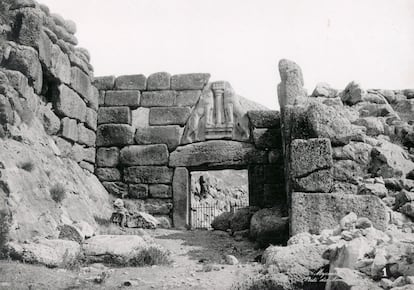
The exhibition does not spare the criticism of Schliemann’s controversial methods, which some historians describe as brutal – even by the standards of the time. Convinced that Homeric Troy was in the deepest strata of Hisarlik, he quickly dug a vertical ditch that destroyed much of the remains. “Troy was not destroyed by the Achaeans, but by Heinrich Schliemann,” reads one of the panels.
Later investigations have determined that the city that might correspond to that of the Iliad is much higher, in the layer now known as Troy VII. Schliemann realized this later and ended up hiring a professional archaeologist, Wilhelm Dörpfeld, to lead the excavations, which were much more careful after that. “His lack of experience and his impatience” proved fatal for the settlement, although Wemhoff points out that the criticism of Schliemann’s methods has been made from the perspective of the 20th century, and mentions that he preserved and cataloged every last piece of ceramic that he found in his digs.
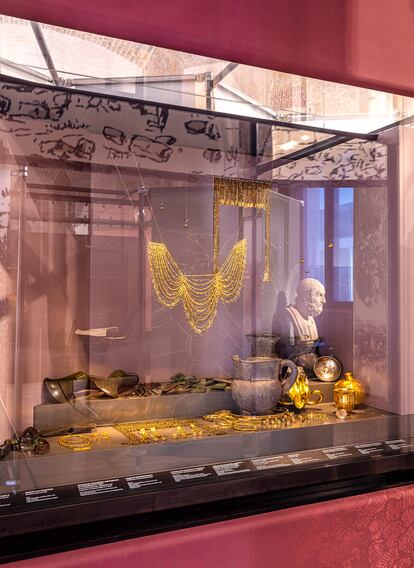
Many of these objects can be seen in the exhibition still bearing the handwritten labels made by Sophia, the adventurer’s second wife, 30 years his junior, who accompanied him on his campaigns. The war in Ukraine stopped other pieces of Priam’s treasure, which were going to travel to Berlin for the exhibition (open until January 8), from being exhibited, as Germany halted its collaboration with Russia, where the gold jewels remained after being looted by the Red Army at the end of World War II. In their place, visitors can see high-quality replicas.
Thousands of letters have been preserved, which he exchanged with dozens of experts from around the world whom he tried to convince of the validity of his theories by organizing academic conferences in Hisarlik. He wrote that he wanted Priam’s treasure, which he donated to the then Imperial Museums on Berlin — he had purchased it from the authorities of the Ottoman Empire after being caught secretly taking it — to never be split. For decades no one knew where the jewels ended up, until in 1994 it became known that the Pushkin Museum had them. Since then, Berlin has demanded its restitution from Moscow.
The archaeologist died in Naples on December 26, 1890, at the age of 62. “Schliemann’s life would make a great movie,” says Wemhoff. “Here, we have tried to present it like this, with all its contrasts and the amazing things that happened and that this man who was 5′1″ tall undertook. He was a tireless person who had an unbreakable will to design his own life and lead it to success.”
Tu suscripción se está usando en otro dispositivo
¿Quieres añadir otro usuario a tu suscripción?
Si continúas leyendo en este dispositivo, no se podrá leer en el otro.
FlechaTu suscripción se está usando en otro dispositivo y solo puedes acceder a EL PAÍS desde un dispositivo a la vez.
Si quieres compartir tu cuenta, cambia tu suscripción a la modalidad Premium, así podrás añadir otro usuario. Cada uno accederá con su propia cuenta de email, lo que os permitirá personalizar vuestra experiencia en EL PAÍS.
¿Tienes una suscripción de empresa? Accede aquí para contratar más cuentas.
En el caso de no saber quién está usando tu cuenta, te recomendamos cambiar tu contraseña aquí.
Si decides continuar compartiendo tu cuenta, este mensaje se mostrará en tu dispositivo y en el de la otra persona que está usando tu cuenta de forma indefinida, afectando a tu experiencia de lectura. Puedes consultar aquí los términos y condiciones de la suscripción digital.
More information
Últimas noticias
Welcome to the post-religion era: The idea of Christianity as the absolute truth has become obsolete
‘I thought you would like it’: The risky sexual practice popularized by TV shows and TikTok
The digitalization of tourism: ‘They promise experiences and gave us the worst possible one’
Mexican peso defies uncertainty with forecasts of a new period of stability in 2026
Most viewed
- Sinaloa Cartel war is taking its toll on Los Chapitos
- Reinhard Genzel, Nobel laureate in physics: ‘One-minute videos will never give you the truth’
- Oona Chaplin: ‘I told James Cameron that I was living in a treehouse and starting a permaculture project with a friend’
- Why the price of coffee has skyrocketed: from Brazilian plantations to specialty coffee houses
- Silver prices are going crazy: This is what’s fueling the rally









































